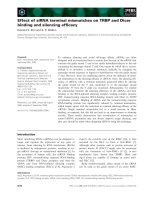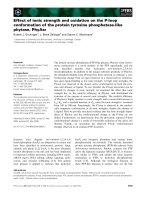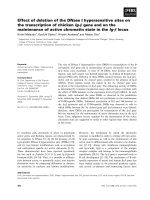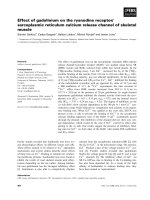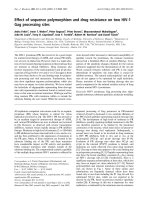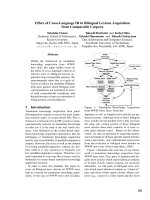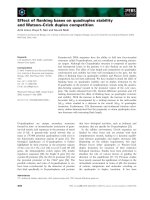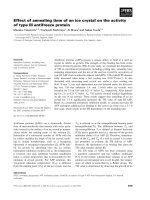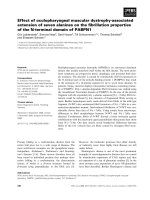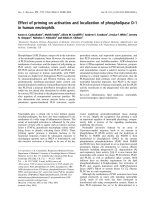Báo cáo khoa học: Effect of oculopharyngeal muscular dystrophy-associated extension of seven alanines on the fibrillation properties of the N-terminal domain of PABPN1 pot
Bạn đang xem bản rút gọn của tài liệu. Xem và tải ngay bản đầy đủ của tài liệu tại đây (772.33 KB, 10 trang )
Effect of oculopharyngeal muscular dystrophy-associated
extension of seven alanines on the fibrillation properties
of the N-terminal domain of PABPN1
Grit Lodderstedt
1
, Simone Hess
2
, Gerd Hause
3
, Till Scheuermann
1,
*, Thomas Scheibel
2
and Elisabeth Schwarz
1
1 Institut fu
¨
r Biotechnologie, Martin-Luther-Universita
¨
t Halle-Wittenberg, Halle, Germany
2 Technische Universita
¨
tMu
¨
nchen, Garching, Germany
3 Biozentrum der Martin-Luther-Universita
¨
t Halle-Wittenberg, Halle, Germany
Protein folding to a conformation distinct from the
native fold gives rise to a wide range of diseases. The
most well-known examples are the spongiform encep-
halopathies, Alzheimer’s, Parkinson’s and Hunting-
ton’s diseases [1–4]. These various disorders have all
been traced to individual proteins that undergo alter-
native folding to a conformation, the characteristic
feature of which is a b-cross structure formed by
b-strands lying perpendicular to the fibril axis [5].
However, the molecular processes that either directly
or indirectly cause these highly fatal illnesses are still
under debate.
Huntington’s disease is one of the most prominent
examples of neurodegenerative diseases that are caused
by trinucleotide expansions of CAG repeats and thus
an expansion of a run of glutamine residues [3]. In the
most extreme cases, expansions of up to 180 glutamines
have been described. Besides Huntington’s disease and
Keywords
AFM; alanine expansions; amyloid-like;
kinetics of fibril formation; OPMD
Correspondence
E. Schwartz, Institut fu
¨
r Biotechnologie,
Martin-Luther-Universita
¨
t Halle-Wittenberg,
Kurt-Mothes-Str. 3, 06120 Halle, Germany
Fax: +49 345 55 27 013
Tel. +49 345 55 24 856
E-mail: Elisabeth.Schwarz@biochemtech.
uni-halle.de
*Present address
Roche Diagnostics GmbH, Penzberg,
Germany
(Received 12 September 2006, revised
2 November 2006, accepted 8 November
2006)
doi:10.1111/j.1742-4658.2006.05595.x
Oculopharyngeal muscular dystrophy (OPMD) is an autosomal dominant
disease that usually manifests itself within the fifth decade. The most prom-
inent symptoms are progressive ptosis, dysphagia, and proximal limb mus-
cle weakness. The disorder is caused by trinucleotide (GCG) expansions in
the N-terminal part of the poly(A)-binding protein 1 (PABPN1) that result
in the extension of a 10-alanine segment by up to seven more alanines. In
patients, biopsy material displays intranuclear inclusions consisting primar-
ily of PABPN1. Poly l-alanine-dependent fibril formation was studied using
the recombinant N-terminal domain of PABPN1. In the case of the protein
fragment with the expanded poly l-alanine sequence [N-(+7)Ala], fibril for-
mation could be induced by low amounts of fragmented fibrils serving as
seeds. Besides homologous seeds, seeds derived from fibrils of the wild-type
fragment (N-WT) also accelerated fibril formation of N-(+7)Ala in a con-
centration-dependent manner. Seed-induced fibrillation of N-WT was con-
siderably slower than that of N-(+7)Ala. Using atomic force microscopy,
differences in fibril morphologies between N-WT and N-(+7)Ala were
detected. Furthermore, fibrils of N-WT showed a lower resistance against
solubilization with the chaotropic agent guanidinium thiocyanate than those
from N-(+7)Ala. Our data clearly reveal biophysical differences between
fibrils of the two variants that are likely caused by divergent fibril struc-
tures.
Abbreviations
AFM, atomic force microscopy; ANS, 8-anilinonaphthalene-1-sulfonate; EM, electron microscopy; OPMD, oculopharyngeal muscular
dystrophy; PABPN1, poly(A)-binding protein nuclear; ThT, thioflavine T.
346 FEBS Journal 274 (2007) 346–355 ª 2006 The Authors Journal compilation ª 2006 FEBS
several other poly l-glutamine-linked diseases, exten-
sions of poly l-alanine stretches have also been reported
as a cause of congenital disorders. However, in contrast
to the massive extensions seen in poly l-glutamine-
based disorders, more than 30 consecutive alanines are
rarely observed upon mutation of GCG repeats in
poly l-alanine-caused illnesses [6]. The sensitivity of
protein folds towards poly l-alanine extensions is evi-
dent from genetic analyses, which have revealed that
two additional alanine residues in poly(A)-binding pro-
tein nuclear (PABPN1) are sufficient to elicit dominant
effects [7]. These findings have been confirmed using an
animal model for oculopharyngeal muscular dystrophy
(OPMD), in which hemizygous transgenic mice with
three additional alanine residues in PABPN1 displayed
myopathic changes [8].
PABPN1 [nuclear poly(A)-binding protein, previ-
ously, PABP2] is involved in mRNA processing in the
cell nucleus [9,10]. Together with cleavage and poly-
adenylation specificity factor, PABPN1 induces proces-
sivity of poly(A)polymerase and controls the length of
poly adenine tails [11–13]. PABPN1 is a 306 amino
acid protein with oppositely charged N- and C-ter-
minal domains. An RNP-type RNA-binding domain,
which lies in the middle of the protein, is preceded by
an a-helical segment [13,14]. The poly l-alanine exten-
sions affect the N-terminal fragment of the protein,
which comprises 125 amino acids. In the wild-type
protein, the sequence (Ala)
10
Gly(Ala)
2
follows the
start methionine. In OPMD patients, this natural
poly l-alanine sequence is extended by up to seven
additional alanine residues yielding a total of 17 ala-
nines in the most extreme case [7]. Biochemical
analyses of PABPN1 with extended poly l-alanine
sequences showed that the protein’s activity in poly
adenylation is not affected (B Schulz and E Wahle,
personal communication). Histochemical analysis of
biopsy material from OPMD patients revealed fibrillar
aggregates in muscle fiber nuclei with PABPN1 as a
major constituent [15,16].
The occurrence of aggregates has been confirmed in
both yeast- and cell-culture models of OPMD [17–22]. It
is not clear, however, whether the observed aggregates
in the model systems represent amyloid-like deposits.
Irrespective of the nature of the aggregates (amorphous
or regular b-cross structures), reduction of aggregate
formation by chemical and ⁄ or molecular chaperones
has been shown to reduce cytotoxicity both in cell cul-
ture [17,18,22,23] and in animal models [19,24]. How-
ever, the mere fact that no correlation between the
frequency of the inclusions and the severity of the dis-
ease can be observed [25], shows that the molecular pro-
cess(es) that elicits OPMD is to date unknown.
We showed previously that recombinant full-length
PABPN1 tends to form amorphous aggregates in vitro
[26]. The formation of amorphous aggregates was inde-
pendent of the presence or length of the poly l-alanine
sequence. In contrast, no amorphous aggregates were
observed with the N-terminal domain of PABPN1. The
N-terminal fragment of wild-type and the variant carry-
ing the most extreme extension observed in man (seven
additional alanine residues) formed fibrillar structures
with a lag phase that was considerably shorter in the
case of the variant with the poly l-alanine extension
[26]. In this work, we further compare these two N-ter-
minal fragments. Differences on the level of fibril for-
mation kinetics and seeding capacity are observed.
Furthermore, the two variants also differ in their fibril
morphologies and stabilities of the fibrils against solu-
bilization.
Results
Seeding of fibril growth of PABPN1 N-terminal
fragment variants
Previous analyses of poly l-alanine-dependent fibril for-
mation of PABPN1 have revealed that the full-length
protein readily forms amorphous aggregates [26].
Although fibril formation also occurred with full-length
PABPN1 upon storage (data not shown), the simulta-
neous presence of both amorphous aggregates and
fibrils hampered the analysis of fibril formation kinetics.
For this reason, fibril formation was analyzed with the
N-terminal domain of PABPN1 consisting of amino
acids 1–125 of the wild-type protein (N-WT). Because
the aim of this study was to investigate the effect on the
fibrillation properties of the most extreme disease-asso-
ciated extension of seven additional alanines, fibrillation
kinetics and fibril properties of N-WT were compared
with those of the corresponding fragment carrying seven
additional alanines (N-(+7)Ala). Both proteins were
recombinantly produced in Escherichia coli cells and
purified as published previously [26].
Fibrillation kinetics were first followed via fluores-
cence measurements with thioflavine T (ThT), a dye
routinely used to monitor fibril formation [27]. How-
ever, to obtain fluorescence signals of sufficient ampli-
tude, protein concentrations > 10 lm had to be used.
We have previously reported unusual tinctorial features
of fibrils of the N-terminal domain of PABPN1 [26]. In
addition, poor staining of fibrils formed by poly alanine
peptides with ThT and resilience against staining with
Congo Red were observed by Shinchuk et al. [28].
Thus, we measured fibril-induced changes of 8-anilino-
naphthalene-1-sulfonate (ANS) fluorescence, a method
G. Lodderstedt et al. Poly L-alanine length dependent fibril properties
FEBS Journal 274 (2007) 346–355 ª 2006 The Authors Journal compilation ª 2006 FEBS 347
that has been described for monitoring fibril formation,
e.g. of the NM domain of the yeast prion protein
Sup35p [29] and also for the detection of a-synuclein
fibrils [30]. In fact, ANS signals showed a linear corre-
lation with the concentration of fibrils of N-(+7)Ala in
a range from 1 to 14 lm, whereas no ANS binding was
observed with the monomeric protein (data not shown).
Because ANS fluorescence measurements allowed a
more sensitive quantification of fibrils than with ThT
(data not shown), this spectroscopic detection method
was employed throughout this study.
When the kinetics of N-(+7)Ala fibril formation
were monitored in the absence of seeds, fibril forma-
tion started after a lag phase of 10 days (Fig. 1A).
In contrast, addition of seeds resulted in an immediate
increase in ANS fluorescence as expected. As a control,
the depletion of the soluble monomeric species was fol-
lowed by RP-HPLC, a method by which the decrease
of monomeric species could be shown to be reciprocal
to the increase in ANS fluorescence (Fig. 1B). Because
we never observed amorphous aggregates with the
N-terminal fragment, we conclude that the increase in
ANS fluorescence correlates with the increase in fibril-
lar species at the expense of monomeric protein.
According to the hypothesis that seeded fibril forma-
tion in the case of the yeast prion protein Sup35p
exhibits a binding equilibrium between soluble interme-
diates and seeding molecules [31,32], an increase in
seed concentration should accelerate fibril formation.
To test this assumption, fibril formation was investi-
gated in the presence of increasing concentrations of
fragmented N-(+7)Ala fibrils acting as seeds. Clearly,
an increase in seed concentration resulted in faster
fibrillation rates (Fig. 2A). Quantification of fibrillation
rates revealed an approximately linear correlation
between seed concentration and fibril growth (Fig. 2B).
A similar dependence of fibrillation rates on seed con-
centration has been demonstrated previously with the
NM domain of Sup35p [31,33].
Induction of fibrillation by seeds was also tested using
N-WT. In the absence of seeds, an increase in ANS
fluorescence was recorded after 30 days (Fig. 3A).
Seeding with fragmented N-WT fibrils resulted in an
immediate increase in ANS fluorescence. However, the
increase in ANS fluorescence was considerably slower
than in the case of seeded reactions with N-(+7)Ala. To
ensure that the increase in ANS fluorescence reflects
fibril growth, quantification of monomeric species of the
seeded reaction by RP-HPLC was performed. This ana-
lysis reveals that monomeric species decreased very
slowly over an incubation time of 25 days, indicating
that induction of fibril growth of N-WT by seeds is
significantly slower than in the case of N-(+7)Ala
(Fig. 3B). Subsequent analyses using AFM confirmed
that N-WT seeds had hardly been elongated to longer
fibrils (Fig. 5C,D). In contrast, seeded samples of
N-(+7)Ala, which revealed small seeds to begin with
(data not shown), showed elongated fibrils after 30 days
of incubation (Fig. 5G,H). Possibly, in the case of
N-WT, conformational change to the fibrillar state is so
slow that most of the seeds lose their ability to act as
polymerization points for soluble N-WT.
Because slow fibril formation of N-WT induced by
N-WT seeds may also be due to less active N-WT
seeds, cross-seeding experiments were performed. As
seen upon the addition of homologous seeds, incuba-
tion of N-(+7)Ala with N-WT seeds resulted in an
incubation time (d)
012345678910
0
10
20
30
40
50
60
70
80
90
100
0
2
4
6
8
10
12
14
16
18
20
22
)
(ANS fluorescence (AU)
% soluble protein ( )
incubation time (d)
0 5 10 15 20 25 30 35
40
ANS fluorescence (AU)
0
2
4
6
8
10
12
14
16
A
B
Fig. 1. Fibril formation kinetics of N-(+7)Ala. The kinetics of fibril
formation were followed using ANS fluorescence in arbitrary units
(AU). (A) Fibril growth of N-(+7)Ala was monitored in the absence
(triangles) and presence (circles) of 0.1% seeds (w ⁄ v). For the ana-
lysis, N-(+7)Ala was incubated at 37 °C at a protein concentration
of 1 m
M. (B) Quantification of the decrease in monomeric species
by RP-HPLC analysis (squares) as indicated in Experimental proce-
dures. For comparison, the concomitant increase in ANS fluores-
cence (circles) is shown.
Poly L-alanine length dependent fibril properties G. Lodderstedt et al.
348
FEBS Journal 274 (2007) 346–355 ª 2006 The Authors Journal compilation ª 2006 FEBS
increase in ANS fluorescence. The increase in the ANS
signal was reciprocal to the decrease in monomeric
species (data not shown) and depended on the num-
bers of seeds added (Fig. 4). Comparison of the fibril-
lation rates with homologous and heterologous seeds
(Table 1) indicated that fibril growth rates of cross-
seeded samples are slower by a factor of 2 in com-
parison with experiments using homologous seeds. The
large standard deviations of the growth rates indicate
that absolute fibrillation rates have to be interpreted
cautiously. We assume that these deviations (in each
experimental set-up, the three different seed concentra-
tions originated from an identical seed preparation)
are due to the following technical difficulties: our pre-
vious experiments have indicated that the seeds quickly
lose their activity upon storage (data not shown). For
this reason, seeds had to be freshly prepared for each
test. Seed preparations showed noticeable batch incon-
sistencies that may be due to chemical modification(s)
caused by the long incubation times which were neces-
sary to obtain fibrils.
Fibrils of N-WT and N-(+7)Ala differ in
morphology and stability
CD analysis of soluble monomeric N-WT and
N-(+7)Ala showed that N-(+7)Ala contains more
a-helical secondary structures than N-WT [26]. Thus,
incubation time (d)
0 5 10 15 20
ANS fluorescence (AU)
0
2
4
6
8
10
12
14
16
18
A
concentration of seeds (w/v)
0.1% 0.2% 0.4%
rates of fibril formation (d
-1
)
0.0
0.2
0.4
0.6
0.8
1.0
1.2
1.4
1.6
B
Fig. 2. Fibril formation kinetics of N-(+7)Ala at different seed con-
centrations. (A) N-(+7)Ala (1 m
M) was incubated at 37 °C with
0.1% (circles), 0.2% (squares) and 0.4% (triangles) seeds (w ⁄ v).
The increase in ANS fluorescence was fitted to a first-order reac-
tion to determine the rates of fibril formation. (B) Rates of fibril for-
mation (per day) as a function of the seed concentration. Error bars
represent variations from two to four separate experiments invol-
ving separate seed preparations.
incubation time (d)
0102030405060708090100
ANS fluorescence (AU)
0
2
4
6
8
10
12
14
A
incubation time (d)
0 5 10 15 20 25 30 35 40 45 50
0
10
20
30
40
50
60
70
80
90
100
0
2
4
6
8
10
12
14
16
18
20
22
ANS fluorescence (AU) ( )
% soluble protein ( )
B
Fig. 3. Fibril formation kinetics of N-WT. (A) N-WT was incubated
at a protein concentration of 1 m
M in the absence (triangles) and
presence (circles) of 0.1% seeds (w ⁄ v). (B) Loss of monomeric
species (squares) in the seeded sample was monitored by
RP-HPLC analysis. For comparison, the concomitant increase in
ANS fluorescence (circles) is shown.
G. Lodderstedt et al. Poly L-alanine length dependent fibril properties
FEBS Journal 274 (2007) 346–355 ª 2006 The Authors Journal compilation ª 2006 FEBS 349
in the as yet unfibrillized form, N-WT and N-(+7)Ala
already display different structural features. Possibly,
these differences at the structural level are reflected in
the different capacities of the two variants to fibrillize
upon seeding. In order to analyze whether structural
differences between N-WT and N-(+7)Ala could also
be detected in the fibrillar forms, fibrils of both vari-
ants were visualized using electron microscopy (EM)
and AFM. Both microscopy techniques revealed fibril
diameters of 6 nm. Although no differences in fibril
morphology could be detected using EM (Fig. 5A,E),
AFM analysis showed a more pronounced fine struc-
ture in N-WT fibrils than in N-(+7)Ala fibrils
(Figs 5B,F and 6). N-WT fibrils resembled a string of
beads not observed for N-(+7)Ala fibrils. The distan-
ces between the beads ranged from 27 to 43 nm
(Fig. 6). These defined substructures could not be
observed with N-(+7)Ala fibrils. We assume that the
different surface morphologies reflect divergent struc-
tural arrangements of the b-strands inside the fibril.
Whether the bead-like structure is caused by twist
repeats or similar substructures, as reported for the
SH3 domain of phosphatidyl inositol-3¢ -kinase and
lysozyme, remains to be clarified [34]. The fact that
beaded fibril morphologies of N-(+7)Ala, which was
seeded with fragmented N-WT fibrils, were not fre-
quently observed (Fig. 5H) may indicate that the seed
structure does not ‘mold’ newly associating molecules
into the existing conformation as has been postulated
for Sup35p [35,36].
Because the different structures detected using AFM
may correlate with different stabilities against solubili-
zation, fibrils of N-WT and N-(+7)Ala were incubated
at increasing concentrations of guanidinium thiocya-
nate, the only denaturing agent identified by us that
can lead to a partial solubilization of the fibrils. First,
solubilization was performed at room temperature
for 6 h. Release of soluble species was quantified by
RP-HPLC and is indicated as the percentage of the
material that had been previously fibrillar (Fig. 7A).
With both variants, 40–50% of the fibrillar protein
was converted into soluble species. Although conver-
sion was not complete, a higher amount of N-WT than
of N-(+7)Ala fibrils was solubilized by guanidinium
thiocyanate concentrations between 3 and 5 m. When
solubilization was performed under more stringent
conditions (16 h at 50 °C), maximal conversion to
monomeric species was obtained with N-WT fibrils
at 1 m guanidinium thiocyanate, whereas those of
N-(+7)Ala required 4 m guanidinium thiocyanate
(data not shown).
In order to detect a possible equilibrium between
fibrils and soluble monomeric species under solubiliz-
ing conditions, the remaining undissolved fibrils were
reincubated with 6 m guanidinium thiocyanate for
24 h. However, no more protein could be dissolved
upon this second incubation ruling out equilibrium
conditions (data not shown). It is currently unclear
whether the remaining guanidinium thiocyanate-resist-
ant material reflects fibrillar core structures that cannot
at all be solubilized or whether heterogeneous fibrils
display differences in resistance against solubilization.
When the kinetics of solubilization were monitored
in the presence of 6 m guanidinium thiocyanate, the
maximal yield of soluble N-WT was obtained after
1 h, whereas for maximal solubilization of N-(+7)Ala
an incubation period of > 20 h was required (Fig. 7B).
Clearly, these results indicate differences in stability
between N-WT and N-(+7)Ala fibrils. Distinct solubi-
lization properties in cell culture, depending on the
length of the poly l-alanine sequence, have recently
been reported for PABPN1 fusion proteins [22]. In
general, the results of the solubilization experiments
Table 1. Rates of N-(+7)Ala fibril formation upon addition of seeds.
Fibrillation in the presence of different concentrations of N-(+7)Ala
seeds (seeding) and N-WT seeds (cross-seeding). Rate constants
were calculated by assuming a first order reaction. Standard devia-
tions are based on three independent experiments.
Concentration
of seeds
(w ⁄ v)
Growth rates
with homologous seeds
(d
)1
)
with heterologous
seeds
(d
)1
)
0.1% 0.4 (± 0.15) 0.2 (± 0.02)
0.2% 0.7 (± 0.25) 0.3 (± 0.02)
0.4% 1.1 (± 0.29) 0.6 (± 0.11)
incubation time (d)
02468101214161820
ANS fluorescence (AU)
0
5
10
15
20
Fig. 4. Cross-seeding of N-(+7)Ala. N-(+7)Ala (1 mM) was incubated
at 37 °C with 0.1% (circles) or 0.2% (squares) seeds (w ⁄ v). Seeds
were derived from fibrils of N-WT.
Poly L-alanine length dependent fibril properties G. Lodderstedt et al.
350
FEBS Journal 274 (2007) 346–355 ª 2006 The Authors Journal compilation ª 2006 FEBS
underscore the unusually high resistance of the fibrils
against denaturation, which may represent a common
feature of fibrils containing poly l-alanine sequences.
Other well-known examples for extreme mechano-
chemical robustness are spider silks which contain
numerous interspersed poly l-alanine repeats [37,38].
Discussion
Previous experiments have shown that fibril formation
of N-(+7)Ala started after a shorter lag phase than
that of N-WT [26]. This finding can be interpreted as
a higher propensity of the N-(+7)Ala variant to adopt
the b-cross state. Fibrils of N-WT and N-(+7)Ala also
differ with respect to the fibril growth rates. In the
case of N-WT, the conversion to the fibrillar confor-
mation is presumably very slow under the applied
conditions. This assumption, and the fact that seeds
lose their activity upon incubation, may be responsible
for the only moderate acceleration of fibril formation
of N-WT by seeds. Consequently, an increase in the
protein concentration and ⁄ or temperature which is
known to reduce the lag phases of fibril formation [26]
may render N-WT fibril growth rates more susceptible
to seeds.
Differences between N-WT and N-(+7)Ala were
also observed at the level of fibril morphology. A likely
interpretation is that the number of alanines deter-
mines the arrangement of the b-strands leading to vari-
ations in the surface structures as well as fibril
stabilities. This assumption would be in good agree-
ment with recent findings by Kirschner and co-workers
who observed poly l-alanine length-dependent differ-
ences in the diffraction patterns in fibrillized peptides
AE
BF
CG
DH
Fig. 5. Visualization of fibrils using EM (A, E) and AFM (B–D, F–H). (A–D), N-WT fibrils; (E,F), N-(+7)Ala fibrils. Fibrils were derived from sam-
ples in which 1 m
M soluble protein had been either incubated in the absence of seeds (A, B, E, F) or in the presence of 0.1% seeds (w ⁄ v)
(C, D, G, H) at 37 °C; N-WT (A–D) was incubated for 60 days, N-(+7)Ala (E–H) for 30 days. N-WT incubated with N-WT seeds (C), N-(+7)Ala
seeds (D), N-(+7)Ala with N-(+7)Ala seeds (G) and N-WT seeds (H). Magnification of EM: 50 000, insets: zoom with a 50 000 magnification.
The scale bars represent 250 nm; insets in (A) and (E): scale bars ¼ 50 nm.
G. Lodderstedt et al. Poly L-alanine length dependent fibril properties
FEBS Journal 274 (2007) 346–355 ª 2006 The Authors Journal compilation ª 2006 FEBS 351
[28]. Furthermore, given that even the incubation tem-
perature can influence the conformation and stability
of the Sup-NM domain [35,36], different fibril struc-
tures caused by additional alanines are likely. The
manner in which the number of alanines determines
the atomic structure of the fibril and the b-strand
arrangements remains to be determined.
Yet, knowledge of the structure and biophysical
analysis of the fibrils alone will not suffice for
understanding the disease causing mechanism, and
in vitro analyses have to be complemented by cell
biological investigations. From a recent analysis of
PABPN1 toxicity in Drosophila, the authors conclu-
ded that OPMD symptoms such as nuclear inclu-
sions do not result from adverse effects of the
poly l-alanine sequence [39]. Rather, the RNA-bind-
ing function of the protein was suggested to evoke
muscle defects and nuclear inclusions. This conclu-
sion was based on investigations employing mutants
in which the RNA-binding domain of PABPN1 had
been either deleted or inactivated by point muta-
tions. The absence of an intact RNA-binding domain
should, however, significantly reduce local concentra-
tions of PABPN1 close to poly(A) tails. Because
fibril formation, like other aggregation processes, is
known to be a concentration-dependent reaction, the
absence of nuclear inclusions in the case of these
mutants may simply be due to the fact that crit-
ical threshold concentrations of PABPN1 for fibril
formation will not be reached at poly(A) tails. The
argument that high local concentrations of PABPN1
facilitate deposit formation is supported by an earlier
study showing that the ability of PABPN1 to form
oligomers is crucial for the formation of intranuclear
inclusions [20].
Fig. 6. Analysis of AFM images to determine substructure widths.
Longitudinal section of N-WT and N-(+7)Ala fibrils obtained using
Nanoscope Section Analysis.
guanidinium thiocyanate (M)
0123456
% protein dissolved
0
10
20
30
40
50
60
A
incubation time (h)
0 1020304050
solubilized fraction
0
20
40
60
80
100
B
Fig. 7. Stability of fibrils against solubilization with guanidinium thio-
cyanate. (A) Solubilization at the indicated guanidinium thiocyanate
concentrations was performed at room temperature for 6 h. (B) Kin-
etics of conversion to monomeric species. Solubilized material after
the various incubation times is shown as percentage of the max-
imal amount of solubilized material. The increase in soluble protein
was monitored by RP-HPLC analysis. Error bars result from two to
three independent experiments. N-WT, triangles; N-(+7)Ala, circles.
Poly L-alanine length dependent fibril properties G. Lodderstedt et al.
352
FEBS Journal 274 (2007) 346–355 ª 2006 The Authors Journal compilation ª 2006 FEBS
However, an alternative scenario for disease devel-
opment can be envisaged: continuous proteolytic cyto-
solic turn-over may be required to keep nuclear levels
of PABPN1 low. This degradation may be reduced
by the presence of an extended poly l-alanine tract.
Evidence for reduced proteasomal degradation by
glycine–alanine repeats due to impaired substrate
unfolding has been reported recently [40]. Further-
more, imbalance in a-synuclein levels due to muta-
tions, overexpression or inefficient proteasomal
removal of a-synuclein has been proposed to induce
fibril formation and thus a-synucleinopathy [41–43].
The observations that the nuclear inclusions found in
OPMD patients colocalize with ubiquitin and the 20S
proteasomal subunit [16,44] and the findings that pro-
teasome inhibitors increase poly l-alanine-induced
cytotoxicity in cell culture [17] would be in accordance
with this disease-causing cascade.
Experimental procedures
Recombinant protein production and purification
Recombinant constructs have been described previously
[26]. The N-terminal fragments of wild-type (N-WT)
and the variant containing seven additional alanine residues
[N-(+7)Ala] were expressed as fusions with N-terminal
His-tags using the T7 vector system (pET15b) from Nov-
agen (Madison, WI). We showed previously that the His-
tag has no influence on fibril formation [26]. As host cells,
the Escherichia coli strain BL21(DE3)Gold with the vector
pUBS520 was employed to circumvent codon usage prob-
lems. Culture conditions were described previously [26] with
the exception that bacteria were grown in fermentors of 8 L
culture volumes with 5% yeast extract (Roth, Karlsruhe,
Germany). Feeding with yeast extract was started at
D
600
¼ 10. Cells were induced with 1 mm isopropyl thio-
b-d-galactoside at D
600
¼ 20 and harvested 3 h after induc-
tion. Biomass was stored at )80 °C. Per gram biomass,
10 mL disruption buffer (50 mm Tris pH 8, 5 mm EDTA,
1mm phenylmethylsulfonyl fluoride) was added. All subse-
quent steps were carried out as described previously [26],
with the exception that elution from the Q Sepharose was
achieved by 300 mm NaCl. Relevant fractions were pooled,
diluted 1 : 1 with 8 m guanidinium hydrochloride (NiGU
Chemie, Waldkraiburg, Germany) and loaded on a
Ni-NTA column (His Bind Resin, Novagen, Darmstadt,
Germany) equilibrated with 4 m guanidinium hydrochlo-
ride, 50 mm Tris, pH 8.0. The column was washed with
buffer containing 20 mm imidazol, 4 m guanidinium hydro-
chloride, 50 mm Tris, pH 8.0. Protein was eluted by a linear
imidazol gradient from 20 to 250 mm within 12 column vol-
umes. Relevant fractions were selected, pooled and further
purified by gel filtration as published [26]. Purified protein
was dialyzed against water, lyophillized and stored at
)80 °C.
Fibril formation and fibril analysis by
ANS fluorescence
Lyophilized protein was dissolved in 5 mm KH
2
PO
4
pH 7.5, 150 mm NaCl, 1% (w ⁄ v) NaN
3
to a final concen-
tration of 1 mm and then incubated at 37 °C for fibril for-
mation to occur. To determine ANS fluorescence, samples
were briefly mixed and then diluted to a final concentration
of 5 lm with 50 lm ANS in 5 mm KH
2
PO
4
, pH 7.5,
150 mm NaCl. Fluorescence spectra were recorded at an
emission wavelength of 480 nm upon excitation at 370 nm
in a Jobin Yvon Spex Fluoromax 2 at 20 °C. Experiments
were performed in 1 cm cuvettes with excitation and emis-
sion slits widths of 5 nm.
Seed preparation
Fibrils were formed by incubation of N-(+7)Ala at a con-
centration of 1 mm for 30 days and N-WT at a concentra-
tion of 2 mm for 100 days. When fibril formation was
completed as monitored by maximal ANS fluorescence
signals, fibrils without further storage were harvested by
centrifugation for 1 h at 260 000 g (OptimaTM TLX
ultracentrifuge), washed with 5 mm KH
2
PO
4
, pH 7.5,
150 mm NaCl, and subjected to pulsed ultrasonification
(3 · 20 s) · 5 using UP200S with an amplitude of 50%.
Seeds were added immediately after preparation to protein
solutions.
Quantification of soluble (monomeric) protein
during fibril formation by RP-HPLC
Samples were diluted 1 : 25 with water to a final protein
concentration of 0.5 mgÆmL
)1
and centrifuged for 1 h at
260 000 g. The supernatant was loaded on a 1.6 mL
EC125 ⁄ 4 Nucleosil 100-5 C
18
column (Machery-Nagel) pre-
equilibrated with 0.05% trifluoroacetic acid in water.
Protein was eluted by an acetonitrile gradient from 0 to
100% with a flow rate of 0.7 mLÆmin
)1
over 90 min. Pro-
tein concentrations were determined by integration of peak
areas after calibration with soluble (monomeric) reference
protein.
EM and AFM
For EM analysis, carbonized copper grids (Plano, Wetzlar,
Germany) were pretreated for 1 min with bacitracin
(0.1 mgÆmL
)1
). After air drying, protein that had been dilu-
ted with water to final concentrations of 0.5 mgÆmL
)1
was
applied for 3 min. Subsequently, grids were again air dried.
Protein (fibrils) was negatively stained with 1% (w ⁄ v)
G. Lodderstedt et al. Poly L-alanine length dependent fibril properties
FEBS Journal 274 (2007) 346–355 ª 2006 The Authors Journal compilation ª 2006 FEBS 353
uranyl-acetate and visualized in a Zeiss EM 900 electron
microscope operating at 80 kV. For AFM, samples were
diluted in water to final concentrations of 1.5 mgÆmL
)1
and
placed on freshly cleaved mica attached to AFM sample
disks (Ted Pella). After 3 min of adsorption at 25 °C, disks
were rinsed three times with Millipore filtered distilled
water. The samples were then allowed to air dry. Tapping
mode imaging was performed on a multimode scanning
probe microscope (Veeco, Santa Barbara, CA) by using
n
+
-silicon probes (type NCH-50, Nanosensors, Neuchatel,
Switzerland). Fibril heights and subunit widths were deter-
mined using the nanoscope analysis software.
Chemical stability of fibrils
The chemical stability of fibrils was tested after the fibrilla-
tion process was completed (no further rise of ANS sig-
nals). The sample containing fibrils was split into seven
aliquots that were centrifuged for 1 h at 70 000 r.p.m.
(OptimaTM TLX ultracentrifuge, Beckman, Fullerton,
CA) and washed with 5 mm KH
2
PO
4
, pH 7.5, 150 mm
NaCl. Fibrils were resuspended in the same buffer contain-
ing different concentrations of guanidinium thiocyanate.
Samples were incubated under shaking (600 r.p.m.) for
different intervals at room temperature or at 50 °C. Sup-
ernatants obtained after centrifugation were analyzed by
RP-HPLC.
Acknowledgements
We thank Elmar Wahle, Christian Lange, Huma
Yonus, Daniel Huster and David Ferrari for critical
comments on the manuscript. This work was funded
by the Deutsche Forschungsgemeinschaft through
Sonderforschungsbereich 610, subproject A9 (ES) and
Sonderforschungsbereich 596, subproject B14 (TS).
References
1 Scheibel T & Buchner J (2006) Protein aggregation as
a cause for disease. In Molecular Chaperones in
Health and Disease; Handbook of Experimental
Pharmacology (Gaestel M, ed.), pp. 199–219. Springer
Verlag, Berlin.
2 Dobson CM (2004) Principles of protein folding,
misfolding and aggregation. Semin Cell Dev Biol 15,
3–16.
3 Everett CM & Wood NW (2004) Trinucleotide repeats
and neurodegenerative disease. Brain 127, 2385–2405.
4 Selkoe DJ (2004) Cell biology of protein misfolding: the
examples of Alzheimer’s and Parkinson’s diseases.
Nature Cell Biol 6, 1054–1061.
5 Makin OS & Serpell LC (2005) Structures for amyloid
fibrils. FEBS J 272, 5950–5961.
6 Amiel J, Trochet D, Cle
´
ment-Ziza M, Munnich A &
Lyonnet S (2004) Polyalanine expansions in humans.
Hum Mol Genet 13, R235–R243.
7 Brais B, Bouchard J-P, Xie Y-G, Rochefort DL, Chre
´
-
tien N, Tome
´
FMS, Lafrenie
`
re RG, Rommens JM,
Uyama E, Nohira O et al. (1998) Short GCG expan-
sions in the PABP2 gene cause oculopharyngeal muscu-
lar dystrophy. Nature Genet 18, 164–167.
8 Hino H, Araki K, Uyama E, Takeya M, Araki M, Yoshi-
nobu K, Miike K, Kawazoe Y, Maeda Y, Uchino M
et al. (2004) Myopathy phenotype in transgenic mice
expressing mutated PABPN1 as a model of oculopharyn-
geal muscular dystrophy. Hum Mol Genet 13, 181–190.
9 Wahle E (1991) A novel poly(A)-binding protein acts as
a specificity factor in the second phase of messenger
RNA polyadenylation. Cell 66, 759–768.
10 Wahle E & Ru
¨
egsegger U (1999) 3¢-End processing of
pre-mRNA in eukaryotes. FEMS Microbiol Rev 23,
277–295.
11 Bienroth S, Wahle E, Suter-Crazzolara C & Keller W
(1991) Purification of the cleavage and polyadenylation
specificity factor involved in the 3¢-processing of messen-
ger RNA precursors. J Biol Chem 266, 19768–19776.
12 Bienroth S, Keller W & Wahle E (1993) Assembly of a
processive messenger RNA polyadenylation complex.
EMBO J 12, 585–594.
13 Kerwitz Y, Ku
¨
hn U, Lilie H, Knoth A, Scheuermann
T, Friedrich H, Schwarz E & Wahle E (2003) Stimula-
tion of poly(A) polymerase through a direct interaction
with the nuclear poly(A) binding protein allosterically
regulated by RNA. EMBO J 22, 3705–3714.
14 Nemeth A, Krause S, Blank D, Jenny A, Jeno
¨
P, Lustig
A & Wahle E (1995) Isolation of genomic and cDNA
clones encoding bovine poly(A) binding protein II.
Nucleic Acids Res 23, 4034–4041.
15 Tome
´
FMS, Chateau D, Helbling-Leclerc A & Fardeau
M (1997) Morphological changes in muscle fibers in
oculopharyngeal muscular dystrophy. Neuromusc Disord
7, 63–69.
16 Calado A, Tome
´
FMS, Brais B, Rouleau GA, Ku
¨
hn U,
Wahle E & Carmo-Fonseca M (2000) Nuclear inclu-
sions in oculopharyngeal muscular dystrophy consist of
poly(A) binding protein 2 aggregates which sequester
poly(A) RNA. Hum Mol Genet 9, 2321–2328.
17 Abu-Baker A, Messaed C, Laganiere J, Gaspar C, Brais
B & Rouleau GA (2003) Involvement of the ubiquitin–
proteasome pathway and molecular chaperones in ocu-
lopharyngeal muscular dystrophy. Hum Mol Genet 12,
2609–2623.
18 Bao YP, Cook LJ, O’Donovan D, Uyama E &
Rubinsztein DC (2002) Mammalian, yeast, bacterial,
and chemical chaperones reduce aggregate formation
and death in a cell model of oculopharyngeal muscular
dystrophy. J Biol Chem 277, 12263–12269.
Poly L-alanine length dependent fibril properties G. Lodderstedt et al.
354
FEBS Journal 274 (2007) 346–355 ª 2006 The Authors Journal compilation ª 2006 FEBS
19 Davies JE, Wang L, Garcia-Oroz L, Cook LJ, Vacher C,
O’Donovan DG & Rubinsztein DC (2005) Doxycycline
attenuates and delays toxicity of the oculopharyngeal
mutation in transgenic mice. Nature Med 11, 672–677.
20 Fan X, Dion P, Laganiere J, Brais B & Rouleau GA
(2001) Oligomerization of polyalanine expanded
PABPN1 facilitates nuclear protein aggregation that is
associated with cell death. Hum Mol Genet 10, 2341–
2351.
21 Tavanez JP, Calado P, Braga J, Lafarga M & Carmo-
Fonseca M (2005) In vivo aggregation properties of the
nuclear poly(A)-binding protein PABPN1. RNA 11,
752–762.
22 Wang Q, Mossner DD & Bag J (2005) Induction of
HSP70 expression and recruitment of HSC70 and
HSP70 in the nucleus reduce aggregation of a polyala-
nine expansion mutant of PABPN1 in HeLa cells. Hum
Mol Genet 14, 3673–3684.
23 Bao YP, Sarkar S, Uyama F & Rubinsztein DC (2004)
Congo red, doxycycline, and HSP70 overexpression
reduce aggregate formation and cell death in cell models
of oculopharyngeal muscular dystrophy. J Med Genet
41, 47–51.
24 Davies JE, Sarkar S & Rubinsztein DC (2006) Treha-
lose reduces aggregate formation and delays pathology
in a transgenic mouse model of oculopharyngeal muscu-
lar dystrophy. Hum Mol Genet 15, 23–31.
25 Uyama E, Tsukahara T, Goto K, Kurano Y, Ogawa
M, Kim Y-J, Uchino M & Arahata K (2000) Nuclear
accumulation of expanded PABP2 gene product in ocu-
lopharyngeal muscular dystrophy. Muscle Nerve 23,
1549–1554.
26 Scheuermann T, Schulz B, Blume A, Wahle E, Rudolph
R & Schwarz E (2003) Trinucleotide expansions leading
to an extended poly-l-alanine segment in the poly(A)
binding protein PABPN1 cause fibril formation. Protein
Sci 12, 2685–2692.
27 LeVine H III (1993) Thioflavine T interaction with syn-
thetic Alzheimer’s disease b-amyloid peptides: detection
of amyloid aggregation in solution. Protein Sci 2, 404–
410.
28 Shinchuk LM, Sharma D, Blondelle SE, Reixach N,
Inouye H & Kirschner DA (2005) Poly-(l-alanine)
expansions form core b-sheets that nucleate amyloid
assembly. Proteins 61, 579–589.
29 Serio TR, Cashikar AG, Moslehi JJ, Kowal AS & Lind-
quist SL (1999) Yeast prion protein [Y
+
] and its deter-
minant Sup35p. Methods Enzymol 309, 649–673.
30 Dusa A, Kaylor J, Edridge S, Bodner N, Hong D-P &
Fink AL (2006) Characterization of oligomers during
a-synuclein aggregation using intrinsic tryptophan fluor-
escence. Biochemistry 45, 2752–2760.
31 Scheibel T, Bloom J & Lindquist SL (2004) The elonga-
tion of yeast prion fibers involves separable steps of
association and conversion. Proc Natl Acad Sci USA
101, 2287–2292.
32 Scheibel T (2004) Amyloid formation of a yeast prion
determinant. J Mol Neurosci 23, 13–22.
33 Collins SR, Douglass A, Vale RD & Weissman JS
(2004) Mechanism of prion propagation: amyloid
growth occurs by monomer addition. Public Library Sci
Biol 2, 1582–1590.
34 Chamberlain AK, MacPhee CE, Zurdo J, Morozova-
Roche LA, Hill HAO, Dobson CM & Davis JJ (2000)
Ultrastructural organization of amyloid fibrils by atomic
force microscopy. Biophys J 79, 3282–3293.
35 Tanaka M, Chien P, Naber N, Cooke R & Weissman
JS (2004) Conformational variations in an infectious
protein determine prion strain differences. Nature 428,
323–327.
36 Tanaka M, Collins SR, Toyama BH & Weissman JS
(2006) The physical basis of how prion conformations
determine strain phenotypes. Nature 442, 585–589.
37 Gatesy J, Hayashi C, Motriuk D, Woods J & Lewis R
(2001) Extreme diversity, conservation, and conver-
gence of spider silk fibroin sequences. Science 291,
2603–2605.
38 Vollrath F & Knight DP (2001) Liquid crystalline spin-
ning of spider silk. Nature 410, 541–548.
39 Chartier A, Benoit B & Simonelig M (2006) A Droso-
phila model of oculopharyngeal muscular dystrophy
reveals intrinsic toxicity of PABPN1. EMBO J 25,
2253–2262.
40 Hoyt MA, Zich J, Takeuchi J, Zhang M, Govaerts C &
Coffino P (2006) Glycine-alanine repeats impair proper
substrate unfolding by the proteasome. EMBO J 25,
1720–1729.
41 Singleton AB, Farrer M, Johnson J, Singleton A,
Hague S, Kachergus J, Hulihan M, Peuralinna T,
Dutra A, Nussbaum R et al. (2003) Alpha-Synuclein
locus triplication causes Parkinson’s disease. Science
302, 841.
42 Kirik D, Annett LE, Burger C, Muzyczka N, Mandel
RJ & Bjo
¨
rklund A (2003) Nigrostriatal a-synucleino-
pathy induced by viral vector-mediated overexpression
of human a-synuclein: a new primate model of
Parkinson’s disease. Proc Natl Acad Sci USA 100,
2884–2889.
43 Liu C-W, Giasson BI, Lewis KA, Lee VM, DeMartino
GN & Thomas PJ (2005) A precipitating role for trun-
cated a-synuclein and the proteasome in a-synuclein
aggregation. J Biol Chem 280, 22670–22678.
44 Dion P, Shanmugan V, Gaspar C, Messaed C, Meijer I,
Toulouse A, Laganiere J, Roussel J, Rochefort D,
Laganiere S et al. (2005) Transgenic expression of an
expanded (GCG)
13
repeat PABPN1 leads to weakness
and coordination defects in mice. Neurobiol Dis 18,
528–536.
G. Lodderstedt et al. Poly L-alanine length dependent fibril properties
FEBS Journal 274 (2007) 346–355 ª 2006 The Authors Journal compilation ª 2006 FEBS 355
